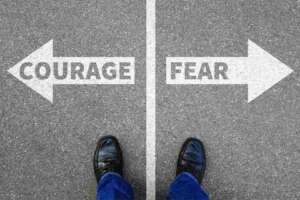Fear in advertising can be a great way to influence human behaviour as it is a powerful emotion that grabs our attention and leaves a lasting impact. It’s no wonder that advertisers have recognized the potential of fear in their campaigns. This article will explore the psychology behind fear in advertising and how it can be harnessed ethically to drive consumer behaviour and, ultimately, business growth.
The psychology behind fear in Advertising
Fear is a primal emotion hardwired into our brains as a survival mechanism. When we encounter a threat, our fight-or-flight response kicks in, flooding our bodies with adrenaline and heightening our senses. Advertisers understand that tapping into this primal fear can trigger a strong emotional response in their audience. This emotional response increases the chances of their message being remembered and acted upon.
One psychological theory that explains why fear can be effective in advertising is the “fear appeal” theory. According to this theory, when people are presented with a fear-inducing message, they are motivated to take action to reduce or eliminate the fear. This can manifest as purchasing a product or adopting a specific behaviour that promises to protect them from the feared outcome.
The Impact of Fear in Advertising on Consumer Behaviour
Fear-based advertising can evoke strong emotions and create a sense of urgency in consumers. When people feel fear, they are more likely to pay attention to and remember the message for longer. This increased attention and memory retention can lead to a higher likelihood of consumers taking the desired action, whether purchasing, subscribing to a service, or changing their behaviour.
Additionally, fear can be a powerful motivator for behaviour change. When consumers are confronted with the potential negative consequences of not taking action, they may be more inclined to act to avoid them. For example, an anti-smoking campaign that highlights the health risks of smoking can instill fear in smokers and motivate them to quit.
Ethical considerations when using fear in advertising
While fear can be a powerful tool in advertising, advertisers need to use it ethically and responsibly. The use of fear should not exploit or manipulate consumers‘ emotions for the sole purpose of driving sales. Advertisers should consider the potential harm fear-based campaigns can cause, such as triggering anxiety or distress in vulnerable individuals.
It is also crucial to ensure the fear in advertising being evoked is relevant to the product or service. Fear should not be used as a sensationalistic tactic to grab attention without a genuine connection to the brand or its offerings. Advertisers must balance creating an emotional impact and maintaining ethical standards.
Types of Fear in Advertising


When it comes to fear appeals in advertising, there are various approaches that marketers can take. One common type is the fear of missing out (FOMO). Marketers can create a sense of urgency and drive immediate action by highlighting the potential loss or regret that consumers may experience if they don’t take advantage of a particular product or service. For example, a travel agency may use fear-based advertising by emphasizing limited-time offers and the fear of missing out on an incredible vacation experience.
Another type of fear appeal is the fear of social rejection. This approach taps into people’s desire for acceptance and belonging. By suggesting that using a specific product or service can help individuals fit in or avoid social embarrassment, marketers can motivate consumers to purchase. An example of this can be seen in advertisements for skin care products that highlight the fear of being judged for having imperfect skin.
Lastly, marketers can use fear appeals by focusing on personal safety and security. This approach is commonly used in advertisements for home security systems, insurance policies, and health-related products. By highlighting the potential risks and dangers that individuals may face without their product or service, marketers can create a sense of vulnerability and the need for protection. This fear-based approach can be highly effective in convincing consumers to take action to safeguard themselves and their loved ones.
Examples of Successful Fear-Based Advertising Campaigns
Throughout history, fear in advertising campaigns has proven highly successful in capturing attention and driving consumer behavior. One notable example is the “Smoking Kills” campaign launched by various health organizations and anti-smoking advocates. Through powerful visuals and hard-hitting messages, this campaign aimed to instil fear in smokers by showcasing the life-threatening consequences of smoking. This fear-based approach successfully motivated many individuals to quit smoking or avoid starting altogether by highlighting potential health risks like lung cancer and heart disease.
Another successful campaign fear-based advertising campaign is the “Click It or Ticket” campaign initiated by the National Highway Traffic Safety Administration (NHTSA) in the United States. This campaign aimed to increase seatbelt usage by highlighting the potential consequences of not buckling up. The campaign emphasized the fear of injury or death in car accidents through television commercials, billboards, and online advertisements. By leveraging fear as a motivator, this campaign significantly increased seatbelt usage rates and helped save lives.
Tips for incorporating fear in advertising effectively


Several strategies can help maximize its impact when incorporating fear into advertising campaigns. First, it is important to understand the target audience and their fears. By identifying the fears and concerns most relevant to the audience, advertisers can craft messages that resonate personally.
Second, providing a solution or a call to action in the advertising message can be effective. When consumers are presented with a fear-inducing message, they are more likely to respond positively if given a solution or a way to mitigate the fear. This can be in the form of a product, a service, or a behaviour change.
Finally, it is vital to balance fear and other emotions. While fear can be a powerful motivator, it should not be the only emotion evoked in an advertising campaign. Incorporating other emotions, such as hope, inspiration, or humour, can help create a more well-rounded and memorable message.
Case Studies of Fear in Advertising Campaigns
Let’s explore two compelling case studies to illustrate the effectiveness of fear in advertising. The first case study focuses on the “Dumb Ways to Die” campaign launched by Metro Trains in Melbourne, Australia. This campaign aimed to raise awareness about train safety by using cute and catchy animated characters to depict various dumb and dangerous behaviours. The campaign effectively instilled fear in viewers by showing the consequences of these behaviours, such as electrocution or being hit by a train. The campaign went viral, garnering millions of views and winning numerous awards. It successfully educated the public about train safety and significantly reduced accidents and deaths on the train tracks.
The second case study revolves around the “Save the Children” campaign called “Most Shocking Second a Day.” This campaign aimed to raise awareness about the Syrian refugee crisis by simulating the experience of a British girl living in a war zone. The video showed the girl’s life deteriorating as the war progressed, evoking a sense of fear and empathy in viewers. The campaign successfully compelled viewers to donate and support the cause by leveraging fear as a motivator. It garnered millions of views on social media platforms and received widespread recognition for its impactful storytelling.
Balancing fear in advertising with other emotions
While fear in advertising can grab attention and motivate action, balancing it with other emotions is essential. Advertisers can create a more holistic and engaging message by incorporating positive emotions such as hope, inspiration, or humour.
For example, Always’s “Like a Girl” campaign aimed to challenge gender stereotypes and empower girls. The campaign used a combination of fear, highlighting the negative impact of gender stereotypes and hope by showcasing the potential for change and empowerment. This balanced approach resonated with audiences and sparked conversations about gender equality.
Criticisms and controversies surrounding fear in Advertising


Despite the potential effectiveness of fear in advertising, it has not been without its criticisms and controversies. One common criticism is that fear appeals can be manipulative and exploit consumers’ emotions for commercial gain. Critics argue that this type of advertising can create unnecessary anxiety and distress, particularly in vulnerable individuals.
Another controversy surrounding fear-based advertising is the potential for desensitization. When consumers are constantly bombarded with fear-inducing messages, they may become desensitized to the fear and become less responsive to the intended message. This highlights the importance for advertisers to carefully consider the frequency and intensity of fear-based campaigns to avoid diminishing returns.
Conclusion
Fear can be a powerful tool in advertising when used ethically and responsibly. By tapping into the psychology of fear, advertisers can capture attention, create emotional connections, and drive consumer behavior. However, advertisers must consider the ethical implications of fear-based campaigns and balance creating an emotional impact and maintaining integrity.
When fear is harnessed effectively, it has the potential to not only drive business growth but also foster positive social change. By raising awareness about important issues, promoting healthier behaviours, or challenging societal norms, fear-based advertising can contribute to a more informed and empowered society.
So the next time you feel a shiver down your spine or a lump in your throat while watching an advertisement, take a moment to reflect on the power of fear in advertising. It may just catalyse personal growth, societal change, and ethical progress.
Contact Markitome for more such marketing tactics.




We hope you’re enjoying reading our blogs… Don’t forget to secure your browsing experience with Nord VPN. Click the banner below to learn more
More To Explore
Redefining Digital Marketing in 2024: 10 Game-Changing Trends
In the ever-evolving world of digital marketing, staying ahead of the curve is essential. As we approach 2024, it’s crucial to be aware of the
SEO Mania-7 Proven Strategies for Explosive SEO Growth in 2024
Understanding the Importance of SEO in 2024 In the ever-evolving world of SEO, staying ahead of the curve is crucial to your online success. As